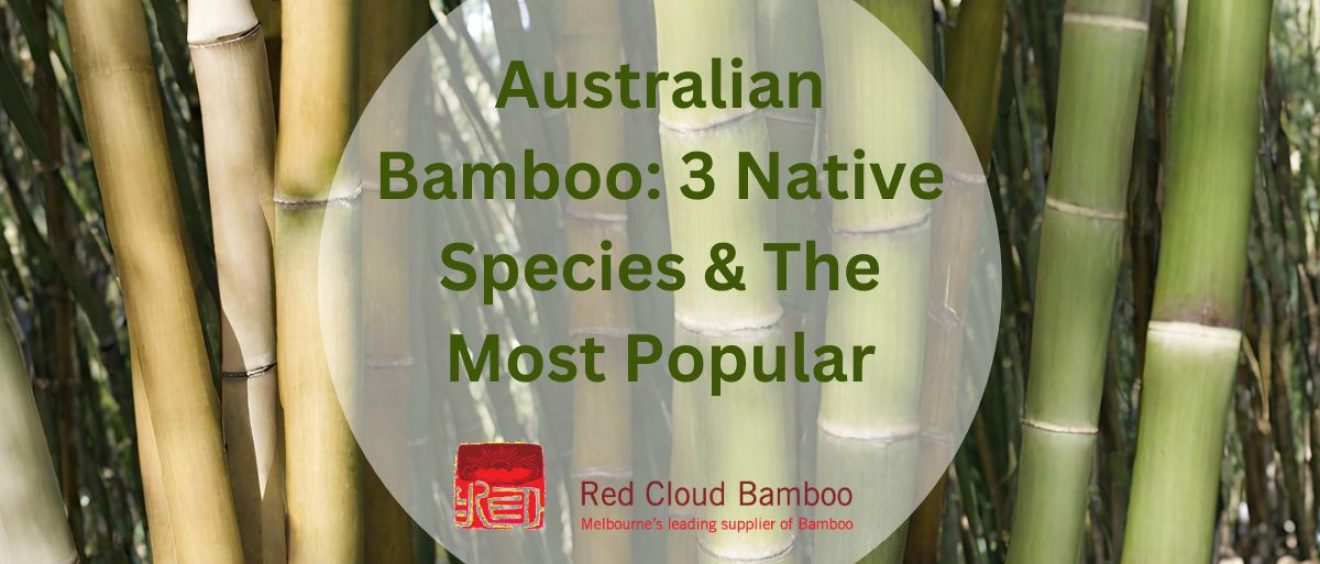
Australian Bamboo: 3 Native Species & The Most Popular
When most people picture bamboo, they think of the lush forests of Asia. But did you know that Australia is also home to its own native bamboo species? For over 60,000 years, Aboriginal Australians sustainably utilised bamboo found in the wild across northern parts of the continent.
In this article, we explore three bamboo species native to Australia, ongoing debate around a possible fourth, and the most popular bamboo now cultivated across the country.
Australia’s Native Bamboo Species
1. Bambusa arnhemica
Found in Arnhem Land in the tropical north, this robust clumping bamboo can reach up to 12 metres tall with thick culms (stems) up to 12 cm wide. It forms dense thickets and is armed with sharp spines, making it an ideal natural barrier. Bambusa arnhemica thrives in the humid, monsoonal conditions of the Northern Territory.
2. Mullerochloa moreheadiana
Growing along coastal Queensland between Mackay and Innisfail, this mid-sized clumping bamboo reaches up to 11 metres. While its culms are thinner (around 4 cm), its bold, lush foliage adds character. This species played a significant role in the material culture of rainforest-dwelling Aboriginal communities.
3. Neololeba atra
Native to the Daintree and nearby wet forests, this species grows to around 8 metres with culms about 5 cm wide. What sets it apart is its underground branching system, where lateral shoots develop roots and continue spreading—a unique trait that makes it incredibly resilient.
Is There a Fourth Native Species?
Some historical accounts reference a bamboo species, possibly Schizostachyum, in the Torres Strait. However, current genetic research suggests it may have been introduced post-colonisation and doesn’t qualify as truly native. The debate continues, illustrating how intertwined natural and human histories can be—and how science continues to uncover the truth.
Aboriginal Uses of Native Bamboo
For Indigenous Australians, bamboo was not just a plant—it was a vital resource.
- Young culms were shaped into spears, didgeridoo mouthpieces, and smoking tubes.
- Mature stalks formed structural supports for shelters, rafts, and tools.
- Trade networks carried bamboo across regions, with groups like the Caledon Bay Balamumu crafting elite fighting spears from these native species.
Though not commonly eaten, bamboo was invaluable for crafting, building, and everyday use.
The Most Popular Bamboo in Australia Today
Despite only a few native species, the most widely planted bamboo in Australia today is Gracilis (Bambusa textilis ‘Gracilis’), often referred to as Slender Weaver Bamboo.
- Grows quickly to around 8 metres
- Naturally compact and non-invasive
- Tolerates everything from tropical to temperate climates
- Excellent for privacy, wind protection, and aesthetics
Gracilis has become the go-to choice for both urban gardens and rural windbreaks. Its graceful, upright form and low maintenance requirements make it ideal for Australian conditions.
Conclusion
Australia’s native bamboos are not only ecologically significant but also deeply rooted in the cultural heritage of its First Nations peoples. While research continues to define their origins and characteristics, their resilience and utility are undeniable.
Among cultivated species, Gracilis stands tall—literally and figuratively—as the most beloved bamboo for modern Australian landscapes.
Whether you’re planting for privacy, beauty, or tradition, bamboo remains one of the most sustainable and rewarding choices you can make.
Bamboo makes good neighbours
Discover the incredible world of bamboo and unlock its limitless potential. Join us at Red Cloud Bamboo, your trusted partner in all things bamboo.
Contact Dale on 9551 8559 or browse our blog for more inspiration. Let’s embrace the resilience and beauty of bamboo together.


